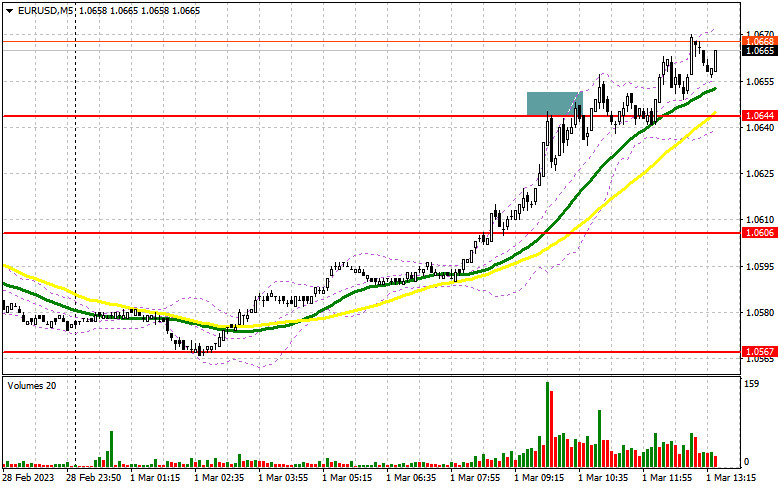
In my morning article, I turned your attention to 1.0644 and recommended making decisions with this level in focus. Now, let's look at the 5-minute chart and figure out what actually happened. Although I expected the euro to recover at the start of this month, I definitely did not count on such rapid growth. A false breakout of 1.0644 led to a sell signal. I had to close my Stop Loss orders as the pair did not decrease lower. For the afternoon, the technical outlook has been revised.

When to open long positions on EUR/USD:
The euro is likely to climb higher if the US economic reports turn out to be weak. The ISM manufacturing index is expected to remain below 50 or contract even more. However, yesterday, traders opened long positions on the US dollar despite weak data. Neel Kashkari's speech could also facilitate a further rise in the US dollar. The euro has been rather volatile lately. If it declines in the American session, it is better to go long after a false breakout of the support level of 1.0641 formed in the morning. Bulls are aiming at the resistance level of 1.0682. The euro is slowly but surely heading to this level now. A breakout and a downward retest of this level amid weak US data will give an entry into long positions with the prospect of a jump to 1.0720. A breakout of 1.0720 will force the bears to close Stop Loss orders. In this case, there might be a trend reversal to an upward one with the likelihood of an increase to 1.0769 where I recommend locking in profits. If EUR/USD declines and bulls show no energy at 1.0641 in the afternoon, the pressure on the pair will return. If this scenario comes true, the pair could reach the support level of 1.0606 where the moving averages are benefiting the bulls. Only a false breakdown there will create a buy signal. You could buy EUR/USD at a bounce from the low of 1.0567 or 1.0533, keeping in mind an upward intraday correction of 30-35 pips.
When to open short positions on EUR/USD:
The sellers may regain the upper hand only if the pair fails to consolidate above the resistance level of 1.0682. If bulls succeed, it will significantly undermine the bearish momentum. So, the pair may start a bull run. An unsuccessful attempt to grow above 1.0682 in the afternoon amid the discouraging US economic reports and a false breakout of this level will give an excellent sell. The pair could decrease to 1.0641. Bulls and bears are likely to tussle for this level. If the pair slides below this level, the pressure on EUR/USD will increase significantly. A breakout and an upward test of this level will generate new entry points into long positions. The price could approach 1.0606, which will boost the bearish bias. A decrease below this level will trigger a drastic drop to 1.0567 where I recommend locking in profits. If EUR/USD rises during the American session and bears show no energy at 1.0682, which is likely, the euro is sure to advance. In this case, I advise you to postpone short positions until a false breakout of 1.0720. You could buy EUR/USD at a bounce from 1.0769, keeping in mind a downward intraday correction of 30-35 pips.

COT report
According to the COT report for January 31, the number of long positions increased, whereas the number of short ones dropped. It is obvious that this happened before the Federal Reserve and the European Central Bank announced their decisions on the key rates. In fact, the COT data from a month ago is of little interest now because of a technical problem in the CFTC that has been recently settled. This week is not rich in macroeconomic events. Therefore, the pressure on risk assets may ease somewhat, thus causing a correction in the euro/dollar pair. According to the COT report, the number of long non-commercial positions climbed by 9,012 to 246,755, whereas the number of short non-commercial positions dropped by 7,149 to 96,246. Consequently, the non-commercial net position came in at 150,509 versus 134,349. The weekly closing price fell to 1.0893 from 1.0919.
Indicators' signals:
Trading is carried out above the 30 and 50 daily moving averages, which indicates bulls' attempts to bolster a further rise.
Moving averages
Note: The period and prices of moving averages are considered by the author on the H1 (1-hour) chart and differ from the general definition of the classic daily moving averages on the daily D1 chart.
Bollinger Bands
If EUR/USD declines, the indicator's lower border at 1.0545 will act as support.
Description of indicators
Moving average (moving average, determines the current trend by smoothing out volatility and noise). Period 50. It is marked yellow on the chart.Moving average (moving average, determines the current trend by smoothing out volatility and noise). Period 30. It is marked green on the chart.MACD indicator (Moving Average Convergence/Divergence - convergence/divergence of moving averages) Quick EMA period 12. Slow EMA period to 26. SMA period 9Bollinger Bands (Bollinger Bands). Period 20Non-commercial speculative traders, such as individual traders, hedge funds, and large institutions that use the futures market for speculative purposes and meet certain requirements.Long non-commercial positions represent the total long open position of non-commercial traders.Short non-commercial positions represent the total short open position of non-commercial traders.Total non-commercial net position is the difference between the short and long positions of non-commercial traders.